My Gardens Have Pests, and That Makes Me Happy
Views: 475
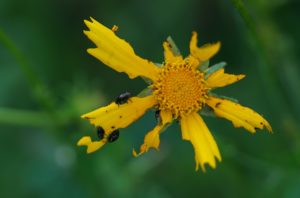
Every spring, a friend posts a meme saying something to the effect of: If your gardens aren’t being eaten, they aren’t part of the ecosystem. I think there’s truth to that. Chances are good that if your gardens are pest free, you’re either applying pesticides, many of which aren’t very good for the environment, or you’ve planted a lot of non-native species that don’t have natural pests in your part of the world. While you may have glorious beauty, you probably aren’t helping native wildlife as much as you could. My gardens have a lot of pests, and that makes me happy. I know I am helping out a host of native creatures including insects, birds, reptiles, amphibians, and mammals large and small.
Pests have seriously damaged three species in my gardens this spring, but I’m actually okay with it. The pests eventually disappear and balance will be restored.
Rose sawfly larvae
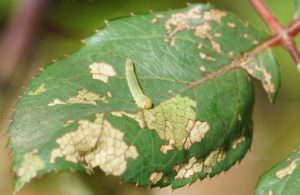
Rose sawfly larvae eating rose leaf.
An unusually cold winter forces me to cut my roses back to the ground. They came up quickly, but I noticed damage to the new growth. Upon close inspection, I found a host of pale yellow caterpillar-looking worms noshing away on my rose leaves. These turned out to be rose sawfly larvae. And yes, they seriously damaged my rose leaves, but I left them alone, and they gradually disappeared. I hope my wrens or blue-gray gnatcatchers picked them off. Birds need thousands of little caterpillars and other insects to feed their young in spring, and I think they look for damaged foliage to find easy meals.
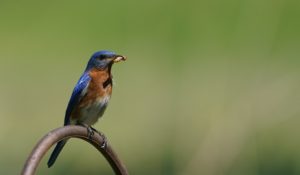
Many birds need large numbers of caterpillars and other insects to feed their young.
Coreopsis beetles
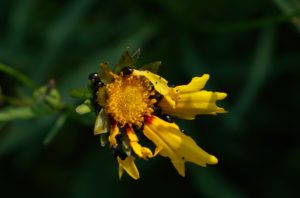
Coreopsis beetles eating coreopsis flower.
This one hurts, because coreopsis is the late spring showstopper in my gardens. They had just started blooming when I noticed my flowers were disappearing as quickly as they opened up. A brief investigation revealed hundreds, if not thousands, of tiny black beetles decimating the flower petals. I believe these beetles are a species of Phaedon, possibly Phaedon desotonis, the aptly named coreopsis beetle. I contacted my extension agent to see if they were interested in this beetle and was reassured that outbreaks happen occasionally, but they didn’t necessarily repeat the next year. We shall see. I’ve already notice fewer of them, so I think something may be eating them, or they are dying off naturally. I hope my toads, frogs, and lizards are having a feast.
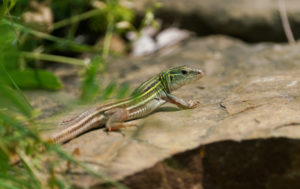
There’s a good chance my six-lined racerunner is eating the coreopsis beetles.
Silvery checkerspot caterpillars
Every year my coneflowers, sunflowers, and black-eyed Susans get wiped out by caterpillars. This makes me happy because any caterpillars that don’t get eaten by birds or other predators will turn into beautiful butterflies. So far this year, I’ve only noticed caterpillars on my large coneflower, but more plants will be affected as the year goes along.

Silvery checkerspot caterpillars eating large coneflower.
I plant a variety of butterfly and moth host plants in the hopes that they will get eaten. When other pests pop up unexpectedly, like the coreopsis beetle and rose sawfly, I understand that this is just part of the natural cycle. In my personal experience, these garden pests rarely kill a plant. While it may get eaten back to the ground, it will come back, if not the same year, then the next. Damage may be unsightly, but it is temporary and a signal to predators that there may be a meal waiting. I love seeing toads and treefrogs and snakes and rabbits making their home here. My yard is actively part of the wider ecosystem surrounding it, and it makes me happy to know that I am helping it thrive.
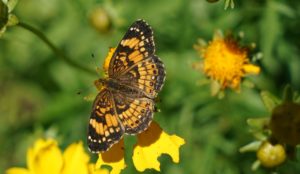
I get beauties like this silvery checkerspot butterfly because I deliberately plant their host plants.
Meet Leslie Miller
Leslie Ann Miller shares 3.5 acres in rural Oklahoma with birds, butterflies and wide variety of animals. She is currently transforming her yard with plantings…
Leslie's Recent Posts

Preparing Your Wildlife Garden for Winter






